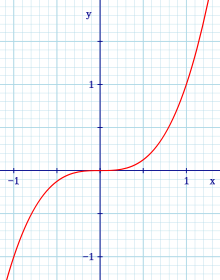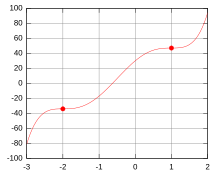Saddle point
In mathematics , a saddle point , terrace point or horizontal turning point is a critical point of a function that is not an extreme point . Points of this kind are, as the last name suggests, special cases of turning points . Saddle points, for example, play a major role in the optimization under constraints when using the Lagrange duality .
One-dimensional case
For functions of a variable with the first derivative disappears at the point
a condition that there is a critical point. If the 2nd derivative is not equal to 0 at this point, there is an extreme point and therefore no saddle point. For a saddle point, the 2nd derivative must be 0 if it exists. However, this is only a necessary condition (for twice continuously differentiable functions), as you can see from the function .
The opposite applies (sufficient condition): If the first two derivatives are equal to 0 and the third derivative not equal to 0, then there is a saddle point; it is therefore a turning point with a horizontal tangent.
This criterion can be generalized: applies to a
if the first derivatives are equal to 0 and the -th derivative not equal to 0, the graph of at has a saddle point.
However, this condition is not necessary. Even if there is a saddle point at the point , all derivatives can be zero.
In the one-dimensional case, a terrace point can be interpreted as a turning point with a tangent parallel to the x-axis.
Example of a completely rational function (polynomial function) with two saddle points
Even fully rational functions of the 5th degree can have two saddle points, as the following example shows:
Because the 1st derivative has two double zeros −2 and 1:
For the 2nd derivative
are −2 and 1 also zeros, but is the 3rd derivative
there not equal to zero:
Therefore and are saddle points of the function .
Multi-dimensional case
Specification via derivatives
For functions of several variables ( scalar fields ) with the gradient disappears at the point
a condition that there is a critical point. The condition means that at that point all partial derivatives are zero. If the Hessian matrix is also indefinite , there is a saddle point.
Specification directly via the function
In the generic case - this means that the second derivative does not vanish in any direction or, equivalently, the Hessian matrix is invertible - the area around a saddle point has a special shape. In the event that such a saddle point with the coordinate axes aligned, can be a saddle point also describe very easily without derivatives: A point is a saddle point of the function if an open environment of there, so
- or.
is fulfilled for all . This clearly means that the function value of in -direction becomes smaller as soon as the saddle point is left, while leaving the saddle point in -direction results in an increase in the function (or vice versa). This description of a saddle point is the origin of the name: A riding saddle tilts downwards perpendicular to the horse's spine , so it represents the direction, while it is in the direction, i.e. H. parallel to the spine, shaped upwards. The mountain saddle is named after the riding saddle , the shape of which also corresponds to the surroundings of a saddle point.
If the saddle point is not aligned in the coordinate direction, the above relationship is established after a coordinate transformation .
Saddle points of this type do not exist in dimension 1: If the second derivative does not disappear here, there is automatically a local maximum or a local minimum. The examples from dimension 1 correspond to degenerate critical points, such as the zero point for the function or for : In both cases there is a direction in which the second derivative vanishes, and accordingly the Hessian matrix is not invertible.
Examples
The function
has the saddle point : is , so is for everyone . For results
- .
That a saddle point is from can also be proven using the derivation criterion. It is
and after inserting results . The Hessian matrix is closed
- ,
and after inserting the saddle point :
Since one eigenvalue of is positive and one is negative , the Hessian matrix is indefinite, which proves that there is actually a saddle point.
Other uses
For the definition in the case of systems of ordinary differential equations, see Autonomous Differential Equation .
















































![\ nabla F (x, y) = \ left [-2x \ left (1+ \ frac {1} {4} (y-1) ^ 2 \ right), (1-x ^ 2) \ frac {y- 1} {2} \ right],](https://wikimedia.org/api/rest_v1/media/math/render/svg/c17b625a6d7176b416de0b04afd096a1a9e145b1)






